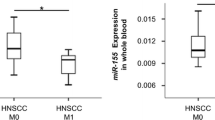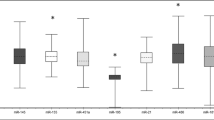Abstract
Head and neck squamous cell carcinomas (HNSCC) is one of the most prevalent type of cancer known in Indian population. Studies are needed to identify the early biomarkers for HNSCC. MicroRNAs (miRNAs) are non-coding RNA molecules, expression of which can be used as biomarker for early diagnosis of HNSCC. For miRNA profiling total RNA, which also contained small RNAs were isolated from ten HNSCC tissue samples and adjacent control. Purity and concentration of eluted RNA was assessed using the NanoDrop1000® spectrophotometer, Reverse Transcription reaction was carried out with megaplex RT primers of pool A and pool B and the expression of selected miRNAs (miR-143/145 and miR-18a/b) was measured using TaqMan primers specific for mature miRNAs. Our study showed dramatic downregulation in expression of two miRNAs, miR-18b and miR-145 in blood samples of HNSCC patients, which are inhibitor of tumorigenesis and can be targeted as biomarker of HNSCC pathogenesis therefore developing avenues for miRNA role in prognosis and therapeutics.






Similar content being viewed by others
Data availability
All data generated or analysed during this study are included in this article (and its supplementary information files). All authors certify that they have no affiliations with or involvement in any organization or entity with any financial interest or non-financial interest in the subject matter or materials discussed in this manuscript.
Abbreviations
- HNSCC:
-
Head and neck squamous cell carcinomas
- miRNAs:
-
MicroRNAs
- RNA:
-
Ribonucleic acid
- HNC:
-
Head and neck cancer
- CT:
-
Cycle threshold
- ROC:
-
Receiver operating characteristic
References
Jemal A, Bray F, Center MM, Ferlay J, Ward E, Forman D. Global cancer statistics. CA: Cancer J Clin. 2011;61(2):69–90. https://doi.org/10.3322/caac.20107.
Capote-Moreno A, Naval L, Muñoz-Guerra MF, Sastre J, Rodríguez-Campo FJ. Prognostic factors influencing contralateral neck lymph node metastases in oral and oropharyngeal carcinoma. J Oral Maxillofac Surg: Off J Am Assoc Oral Maxillofac Surg. 2010;68(2):268–75. https://doi.org/10.1016/j.joms.2009.09.071.
O’Connor SJ. Continuing disparities in survival rates between younger and older cancer patients in Europe. Might oral chemotherapy provide one solution to the problem? Eur J Cancer Care. 2010;19(4):421–3. https://doi.org/10.1111/j.1365-2354.2010.01200.x.
Yadav SK, Pandey A, Sarkar S, Yadav SS, Parmar D, Yadav S. Identification of altered blood MicroRNAs and plasma proteins in a rat model of parkinson’s disease. Mol Neurobiol. 2022;59(3):1781–98. https://doi.org/10.1007/s12035-021-02636-y.
Bartel DP. MicroRNAs: genomics, biogenesis, mechanism, and function. Cell. 2004;116(2):281–97. https://doi.org/10.1016/s0092-8674(04)00045-5.
Griffiths-Jones S. The microRNA Registry. Nucleic acids research. 2004; 32(Database issue):D109–11; https://doi.org/10.1093/nar/gkh023.
Hanahan D, Weinberg RA. Hallmarks of cancer: the next generation. Cell. 2011;144(5):646–74. https://doi.org/10.1016/j.cell.2011.02.013.
Esquela-Kerscher A, Slack FJ. Oncomirs - microRNAs with a role in cancer. Nat Rev Cancer. 2006;6(4):259–69. https://doi.org/10.1038/nrc1840.
Cowland JB, Hother C, Grønbaek K. MicroRNAs and cancer. APMIS : Acta Pathologica, Microbiologica, et Immunologica Scandinavica. 2007;115(10):1090–106. https://doi.org/10.1111/j.1600-0463.2007.apm_775.xml.x.
Ali Syeda Z, Langden SSS, Munkhzul C, Lee M, Song SJ. Regulatory mechanism of MicroRNA expression in Cancer. Int J Mol Sci. 2020. https://doi.org/10.3390/ijms21051723.
Akao Y, Nakagawa Y, Naoe T. MicroRNA-143 and -145 in colon cancer. DNA Cell Biol. 2007;26(5):311–20. https://doi.org/10.1089/dna.2006.0550.
Dar AA, Majid S, Rittsteuer C, de Semir D, Bezrookove V, Tong S, et al. The role of miR-18b in MDM2-p53 pathway signaling and melanoma progression. J Natl Cancer Inst. 2013;105(6):433–42. https://doi.org/10.1093/jnci/djt003.
Shao Y, Qu Y, Dang S, Yao B, Ji M. MiR-145 inhibits oral squamous cell carcinoma (OSCC) cell growth by targeting c-Myc and Cdk6. Cancer Cell Int. 2013;13(1):51. https://doi.org/10.1186/1475-2867-13-51.
Götte M, Mohr C, Koo CY, Stock C, Vaske AK, Viola M, et al. miR-145-dependent targeting of junctional adhesion molecule A and modulation of fascin expression are associated with reduced breast cancer cell motility and invasiveness. Oncogene. 2010;29(50):6569–80. https://doi.org/10.1038/onc.2010.386.
Bufalino A, Cervigne NK, de Oliveira CE, Fonseca FP, Rodrigues PC, Macedo CC, et al. Low miR-143/miR-145 Cluster Levels Induce Activin A Overexpression in Oral Squamous Cell Carcinomas, Which Contributes to Poor Prognosis. PloS one. 2015; 10(8):e0136599; https://doi.org/10.1371/journal.pone.0136599.
Larsson E, Fredlund Fuchs P, Heldin J, Barkefors I, Bondjers C, Genové G, et al. Discovery of microvascular miRNAs using public gene expression data: miR-145 is expressed in pericytes and is a regulator of Fli1. Genome Med. 2009;1(11):108. https://doi.org/10.1186/gm108.
Zhang J, Guo H, Zhang H, Wang H, Qian G, Fan X, et al. Putative tumor suppressor miR-145 inhibits colon cancer cell growth by targeting oncogene Friend leukemia virus integration 1 gene. Cancer. 2011;117(1):86–95. https://doi.org/10.1002/cncr.25522.
Akao Y, Nakagawa Y, Kitade Y, Kinoshita T, Naoe T. Downregulation of microRNAs-143 and -145 in B-cell malignancies. Cancer Sci. 2007;98(12):1914–20. https://doi.org/10.1111/j.1349-7006.2007.00618.x.
Ostenfeld MS, Bramsen JB, Lamy P, Villadsen SB, Fristrup N, Sørensen KD, et al. miR-145 induces caspase-dependent and -independent cell death in urothelial cancer cell lines with targeting of an expression signature present in Ta bladder tumors. Oncogene. 2010;29(7):1073–84. https://doi.org/10.1038/onc.2009.395.
Spizzo R, Nicoloso MS, Lupini L, Lu Y, Fogarty J, Rossi S, et al. miR-145 participates with TP53 in a death-promoting regulatory loop and targets estrogen receptor-alpha in human breast cancer cells. Cell Death Differ. 2010;17(2):246–54. https://doi.org/10.1038/cdd.2009.117.
Kolenda T, Guglas K, Kopczyńska M, Sobocińska J, Teresiak A, Bliźniak R, et al. Good or not good: role of miR-18a in cancer biology. Rep Pract Oncol Radiother: J Greatpoland Cancer Center Poznan Polish Soc Radiat Oncol. 2020;25(5):808–19. https://doi.org/10.1016/j.rpor.2020.07.006.
Aho S, Buisson M, Pajunen T, Ryoo YW, Giot JF, Gruffat H, et al. Ubinuclein, a novel nuclear protein interacting with cellular and viral transcription factors. J Cell Biol. 2000;148(6):1165–76. https://doi.org/10.1083/jcb.148.6.1165.
Wu J, Du W, Wang X, Wei L, Pan Y, Wu X, et al. Erratum: ras-related protein Rap2c promotes the migration and invasion of human osteosarcoma cells. Oncol Lett. 2021;21(6):462. https://doi.org/10.3892/ol.2021.12723.
Taniguchi K, Iwatsuki A, Sugito N, Shinohara H, Kuranaga Y, Oshikawa Y, et al. Oncogene RNA helicase DDX6 promotes the process of c-Myc expression in gastric cancer cells. Mol Carcinog. 2018;57(5):579–89. https://doi.org/10.1002/mc.22781.
Yan SM, Tang JJ, Huang CY, Xi SY, Huang MY, Liang JZ, et al. Reduced expression of ZDHHC2 is associated with lymph node metastasis and poor prognosis in gastric adenocarcinoma. PloS one. 2013;8(2):e56366; https://doi.org/10.1371/journal.pone.0056366.
Liao JC, Yang TT, Weng RR, Kuo CT, Chang CW. TTBK2: a tau protein kinase beyond tau phosphorylation. BioMed Res Int. 2015;2015:575170; https://doi.org/10.1155/2015/575170.
Deb S, Xu H, Tuynman J, George J, Yan Y, Li J, et al. RAD21 cohesin overexpression is a prognostic and predictive marker exacerbating poor prognosis in KRAS mutant colorectal carcinomas. Br J Cancer. 2014;110(6):1606–13. https://doi.org/10.1038/bjc.2014.31.
Cho YG, Kim CJ, Song JH, Rhie DJ, Park YK, Kim SY, et al. Genetic and expression analysis of the KCNRG gene in hepatocellular carcinomas. Exp Mol Med. 2006;38(3):247–55. https://doi.org/10.1038/emm.2006.30.
Yan D, Shen M, Du Z, Cao J, Tian Y, Zeng P, et al. Developing ZNF gene signatures predicting radiosensitivity of patients with breast Cancer. J Oncol. 2021;2021:9255494; https://doi.org/10.1155/2021/9255494.
Xiao Y, Chen Y, Peng A, Dong J. The phosphatase CTDSPL2 is phosphorylated in mitosis and a target for restraining tumor growth and motility in pancreatic cancer. Cancer Lett. 2022;526:53–65; https://doi.org/10.1016/j.canlet.2021.11.018.
Acknowledgments
Authors acknowledge Council of Scientific and Industrial Research (CSIR) for funding the work carried out in the present study through InDepth project (BSC0111). Nishant Singh and Sanjeev Kumar Yadav is grateful CSIR, New Delhi, for providing JRF/SRF fellowship.
Author information
Authors and Affiliations
Contributions
Conceptualization: [Arun Kumar Yadav, MLB Bhatt, Sanjay Yadav]; Methodology: [Arun Kumar Yadav, Sanjay Yadav]; Formal analysis and investigation: [Arun Kumar Yadav, Nishant Singh, Sanjeev Kumar Yadav, Amit Pandey, Dev Kumar Yadav], Writing – original draft preparation: [Arun Kumar Yadav, Nishant Singh, Sanjeev Kumar Yadav, Sanjay Yadav]; Writing - review and editing: [Arun Kumar Yadav, Nishant Singh, Sanjeev Kumar Yadav, Sanjay Yadav], Supervision: [MLB Bhatt, Sanjay Yadav].
Corresponding author
Ethics declarations
Conflict of interest
The authors declare that there is no conflict of interest.
Human and animals rights
The study was approved by the Institutional Ethics committee of King George’s Medical University (KGMU) U.P., India (1667/Ethics/R.cell-17). The methods employed in this investigation follow the guidelines laid out in the Declaration of Helsinki.
Informed consent
A written informed consent was obtained from the study participant or legal guardian and was explained about the study procedure.
Consent to participate
All the participants or legal guardians are provided written informed consent for the participation in this study.
Additional information
Publisher's Note
Springer Nature remains neutral with regard to jurisdictional claims in published maps and institutional affiliations.
Supplementary Information
Below is the link to the electronic supplementary material.
Rights and permissions
Springer Nature or its licensor (e.g. a society or other partner) holds exclusive rights to this article under a publishing agreement with the author(s) or other rightsholder(s); author self-archiving of the accepted manuscript version of this article is solely governed by the terms of such publishing agreement and applicable law.
About this article
Cite this article
Yadav, A.K., Singh, N., Yadav, S.K. et al. Expression of miR-145 and miR-18b in Peripheral Blood Samples of Head and Neck Cancer Patients. Ind J Clin Biochem 38, 528–535 (2023). https://doi.org/10.1007/s12291-023-01119-2
Received:
Accepted:
Published:
Issue Date:
DOI: https://doi.org/10.1007/s12291-023-01119-2




